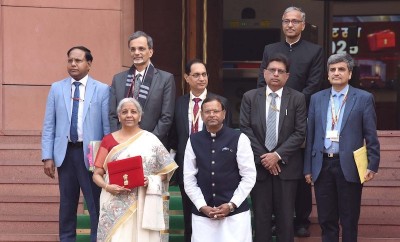 Economic Survey
Economic Survey
Economic Survey says adopting BIM needed to reduce project delays
In recent years, various aspects of infrastructure development have been integrated with technology to improve the efficiency of infrastructure plans, designs, and assets, states the Economic Survey 2023-24 tabled by Union Minister of Finance & Corporate Affairs Nirmala Sitharaman, in Parliament on Monday.
The survey says that some of the most significant uses of technology made possible through PM GatiShakti, Bhuvan, BharatMaps, Single Window Systems, PARIVESH portal, National Data Analytics Platform, Unified Logistics Interface Platform, Pro-Active Governance and Timely Implementation (PRAGATI), India Investment Grid (IIG) and many similar dashboards and data stacks for almost all ministries.
TELECOMMUNICATION SECTOR
The Economic Survey notes that the usage and underlying technologies of telecommunications have undergone massive changes, especially in the past decade.
It says that the Telecommunications Act 2023 was enacted to amend and consolidate the laws on telecommunication services and networks, assignment of spectrum and related matters.
Highlighting the importance of test labs for ensuring the functionality, reliability and interoperability of telecommunications devices, the Survey observes that these specialised facilities are equipped with advanced testing infrastructure to evaluate the performance of various telecommunications equipment such as routers, switches, base stations, and communication protocols.
It observes that more than 69 labs have been designated as conformity assessment bodies for EMI/EMC, safety evaluations, technical requirements and RF testing of telecom products.
The Survey further notes that the Government has introduced guidelines for the Spectrum Regulatory Sandbox (SRS), or Wireless Test Zones (WiTe Zones), as part of the Millennium SRS initiative to foster innovation, enhance ease of doing business, promote “Make in India” in the telecommunications sector.
The survey states that, “This initiative provides a simplified regulatory framework to facilitate Research and Development (R&D) activities, promote exploration of spectrum bands and drive technological advancements”.
WiTe Zones have been categorised into urban or remote areas for experimentation across various frequency bands, with eligibility extending to academia, R&D labs, telecom providers and others, says the Survey.
ELECTRONICS & INFORMATION TECHNOLOGY SECTOR
The Government has envisioned the India AI programme as a mission-centric approach for leveraging transformative technologies to boost inclusion, innovation, and adoption for social impact,mentions the Survey 2023-24.
According to the Survey, pillars of India AI include AI in Governance, AI IP & Innovation, AI Compute & Systems, Data for AI, Skilling in AI, and AI Ethics & Governance. “As part of building ‘AI in India and AI for India’, the first edition of the IndiaAI was released in October 2023”, notes the Survey.
Being the founding member of the Global Partnership on Artificial Intelligence (GPAI), the Survey says that India has contributed to the GPAI goals and objectives and is working on various domestic initiatives for the responsible development, deployment, and adoption of AI. Further, it states that the Union Cabinet has approved an allocation of over ₹10,300 crore towards the comprehensive IndiaAl Mission to democratise access to Al innovation pillars and ensure global competitiveness of India’s Al ecosystem. “Under the Digital India programme, initiated in July 2015 to transform India into a digitally empowered society and knowledge economy, various digital initiatives have been undertaken for the delivery of citizen-centric services”, the Survey mentions.
BUILDING INFORMATION MODELLING (BIM)
For complex infrastructure projects in India, the Economic Survey states, adopting Building Information Modelling can reduce the average project delays of 39 months, reduce infrastructure construction costs up to 30 per cent, maintenance costs up to 20 per cent, information and systemic inefficiencies up to 20 per cent, construction sector related carbon emission up to 38 per cent, water consumption up to 10 per cent and improve investments in construction R&D by one per cent, and result in over four million skilled professional employment and about 2.5 million additional construction sector jobs by reinvesting savings in additional infrastructure.
The motto of BIM is to construct digitally before constructing physically, notes the Survey. It says that NITI Aayog has identified the challenges, solutions and enablers related to BIM implementation. “Based on a roadmap for creating an ecosystem towards faster adoption of BIM in India, guidance, and strategies are being provided to infrastructure projects, including Central Vista, New Parliament, and Central Secretariat”, it mentions further.
The Economic Survey states that the BIM is now being extensively utilised and leveraged by some ministries and departments like the National Capital Region Transport Corporation, all metro rails, select complex industrial and tourism projects, various airports, along with organisation-wise acceptance at Central Public Works Department and extensive digitalisation in the form of Data Lake across NHAI that is now being extended to the entire Ministry of Road Transport & Highways.
Support Our Journalism
We cannot do without you.. your contribution supports unbiased journalism
IBNS is not driven by any ism- not wokeism, not racism, not skewed secularism, not hyper right-wing or left liberal ideals, nor by any hardline religious beliefs or hyper nationalism. We want to serve you good old objective news, as they are. We do not judge or preach. We let people decide for themselves. We only try to present factual and well-sourced news.







